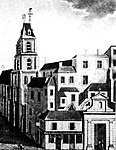Paris 2 Panthéon-Assas University
Paris-Panthéon-Assas University (French: Université Paris-Panthéon-Assas; [ynivɛʁsite pɑ̃teɔ̃ asas]), commonly known as Assas ([asas]) or Paris 2 (French: Paris II [paʁi dø]), is a university in Paris, often described as the top law school of France. It is considered as the direct inheritor of the Faculty of Law of Paris, the second-oldest faculty of Law in the world, founded in the 12th century.Following the division of the University of Paris (known as the "Sorbonne") in 1970, after the events of May 68, law professors had to decide about the future of their faculty. Most of the law professors (88 out of 108) chose to perpetuate the Faculty of Law of Paris by creating and joining a university of law offering the same programs within the same two buildings that hosted the Faculty of Law. The remaining professors joined multidisciplinary universities, including the new Paris 1 Panthéon-Sorbonne University. Panthéon-Assas currently provides the law courses of the Sorbonne University as an independent university, having refused to officially merge into it as a faculty.The majority of the nineteen campuses of Panthéon-Assas are located in the Latin Quarter, with the main campuses on Place du Panthéon and Rue d'Assas, hence its current name. The university is composed of five departments specialising in law, political science, economics, journalism and media studies and public and private management, and it hosts twenty-four research centres and five specialised doctoral schools. Every year, the university enrolls approximately 18,000 students, including more than 3,000 international students.
Excerpt from the Wikipedia article Paris 2 Panthéon-Assas University (License: CC BY-SA 3.0, Authors).Paris 2 Panthéon-Assas University
Place du Panthéon, Paris 5th Arrondissement (Paris)
Geographical coordinates (GPS) Address Nearby Places Show on map
Geographical coordinates (GPS)
| Latitude | Longitude |
|---|---|
| N 48.846944444444 ° | E 2.3447222222222 ° |
Address
Université Paris II Panthéon-Assas
Place du Panthéon 12
75005 Paris, 5th Arrondissement (Paris)
Ile-de-France, France
Open on Google Maps







